For decades, scientists have been trying to tie-up the two major concepts that best explain the workings of the Universe from the very big – general relativity – to the very small – quantum mechanics into one all-encompassing hypothesis known as the “theory of everything.” One leading contender that could unite the two principles into one framework is string theory; a theory that relies on the presence of a tiny particle called an axion.
However, while recently observing some of the largest structures in the universe for this sub-atomic particle, researchers have come up empty-handed; a finding that could deal a serious blow for both of these long-held theories.
String theory is the idea that all fundamental particles are actually tiny one dimensional vibrating loops of string and each type of vibration corresponds to a different particle.
On distance scales larger than the string scale, a string will look just like an ordinary particle, and would have mass and charge. But look at these really close up and you would see that these particles are not point-like dots, but rather minute strings that are so tiny that our best instruments cannot tell that they are not points.
There are many different models of how string theory should work and lots of them predict that a particle known as an axion should exist.
Although they have yet to be detected, axions should have incredibly low masses, from as low as about a millionth of the mass of an electron down to zero mass, but the precise mass range has not been determined
Some scientists think that axions could explain the mystery of dark matter, but another interesting property of these ultra-low-mass particles is that they can convert into a photon (packets of light) when they pass through a magnetic field.
The reverse might also be true in that photons may also be converted into axions under certain conditions. How often this conversion occurs depends on their "convertibility; in other words how easily they can make the switch.
String theory also predicts large numbers of particles that behave like axions, called “axion-like” particles.
While axions would have a single convertibility value at each mass, axion-like particles would have a range of convertibility at the same mass and so should be easier to spot.
With this in mind, a team of astronomers led Christopher Reynolds at the University of Cambridge in the UK, looked for signs of conversion by axion-like particles in material falling towards the supermassive black hole in the center of the Perseus galaxy cluster.
"While it may sound like a long shot to look for tiny particles like axions in gigantic structures like galaxy clusters, they are actually great places to look," said co-author of the recent paper submitted to The Astrophysical Journal, David Marsh, who is based at the Stockholm University in Sweden.
For five days, the team poured over data taken by the Chandra X-ray telescope observations of this high energy radiation streaming out from the heart of the galaxy cluster located 200 million light-years away.
"Galaxy clusters contain magnetic fields over giant distances, and they also often contain bright X-ray sources. Together these properties enhance the chances that conversion of axion-like particles would be detectable,” Marsh said.
Unluckily for string theory, the team came up short on detections of most types of axion-like particles in the mass range their observations were sensitive to.
While this does not dismiss string theory altogether, it does deliver a blow to certain models within that family of ideas.
"Our research doesn't rule out the existence of these particles, but it definitely doesn't help their case," said co-author Helen Russell of the University of Nottingham in the UK. "These constraints dig into the range of properties suggested by string theory, and may help string theorists weed their theories.”
A lack of detections is certainly a compelling argument to suggest axion-like particles do not exist. However, it could be that the particles have even lower convertibility values than this observation's detection limit, and lower than some particle physicists have expected say the team.
Alternatively, the particles also could have higher masses than probed with the Chandra data.
"Until recently I had no idea just how much X-ray astronomers bring to the table when it comes to string theory, but we could play a major role," says Reynolds. "If these particles are eventually detected it would change physics forever."











